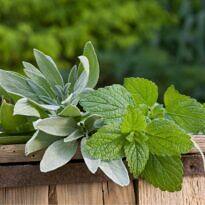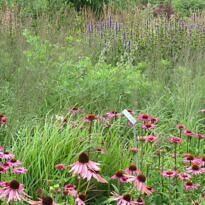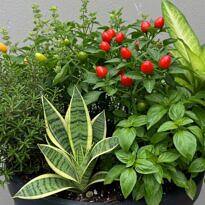Have you heard of vertical gardening?
It’s a growing trend in the world of gardening and landscaping that allows you to transform small or large spaces into lush, vibrant green areas, and the best part is that it climbs the walls! Without taking up space.
In this article, we’ll explore everything you need to know about vertical gardening, from what it is to how to start your own vertical garden at home or in your apartment. Are you ready to dive into this incredible world of vertical gardens?
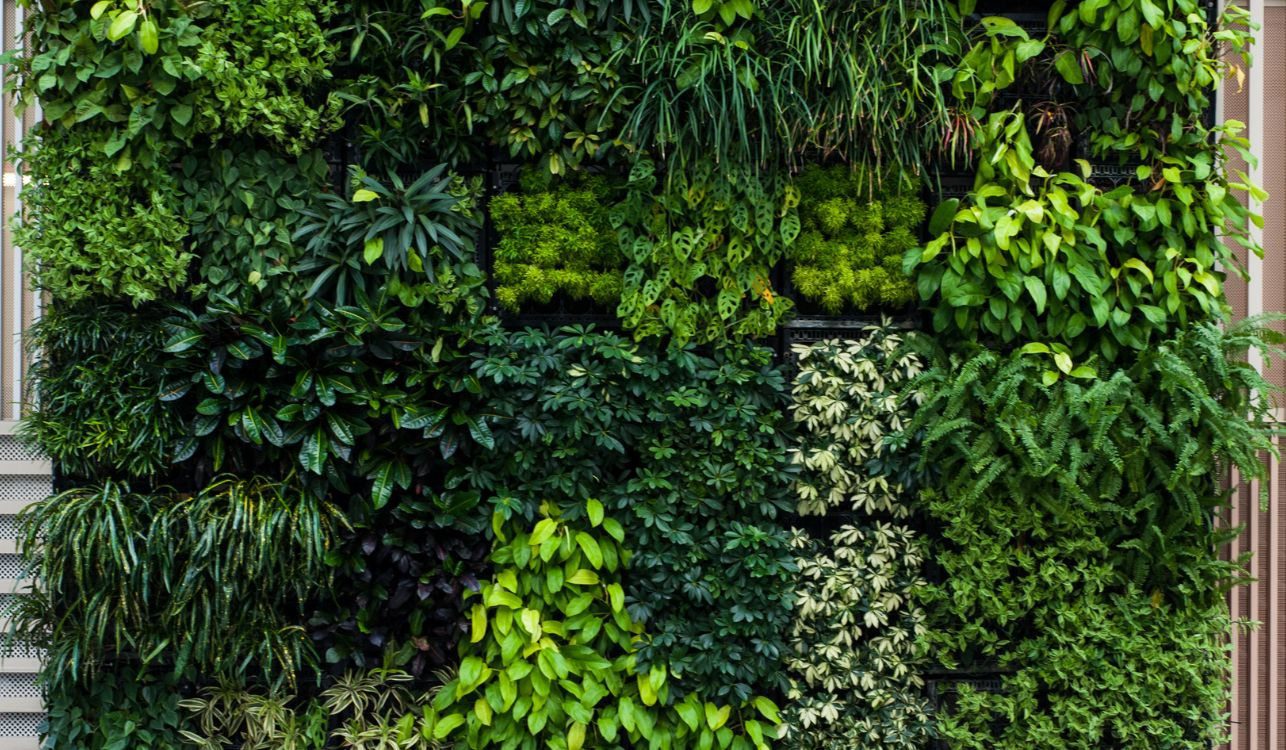
What is Vertical Gardening?
Have you heard about vertical gardening? It’s a growing trend in the world of gardening and landscaping that allows you to transform small or large spaces into lush and vibrant green areas, and the best part is that they climb the walls! Without taking up space.
In this article, we’ll explore everything you need to know about vertical gardening, from what it is to how to start your own vertical garden at home or in an apartment. Shall we dive into this amazing world of vertical gardens?
Solving the Space Challenge
What are the main motivations for adopting vertical gardening?
The answer is simple: space. In urban areas, compact apartments, or small yards, horizontal space is becoming increasingly valuable and often scarce. Vertical gardening elegantly solves this challenge, allowing practically anyone to create their own private green oasis, regardless of the available space.
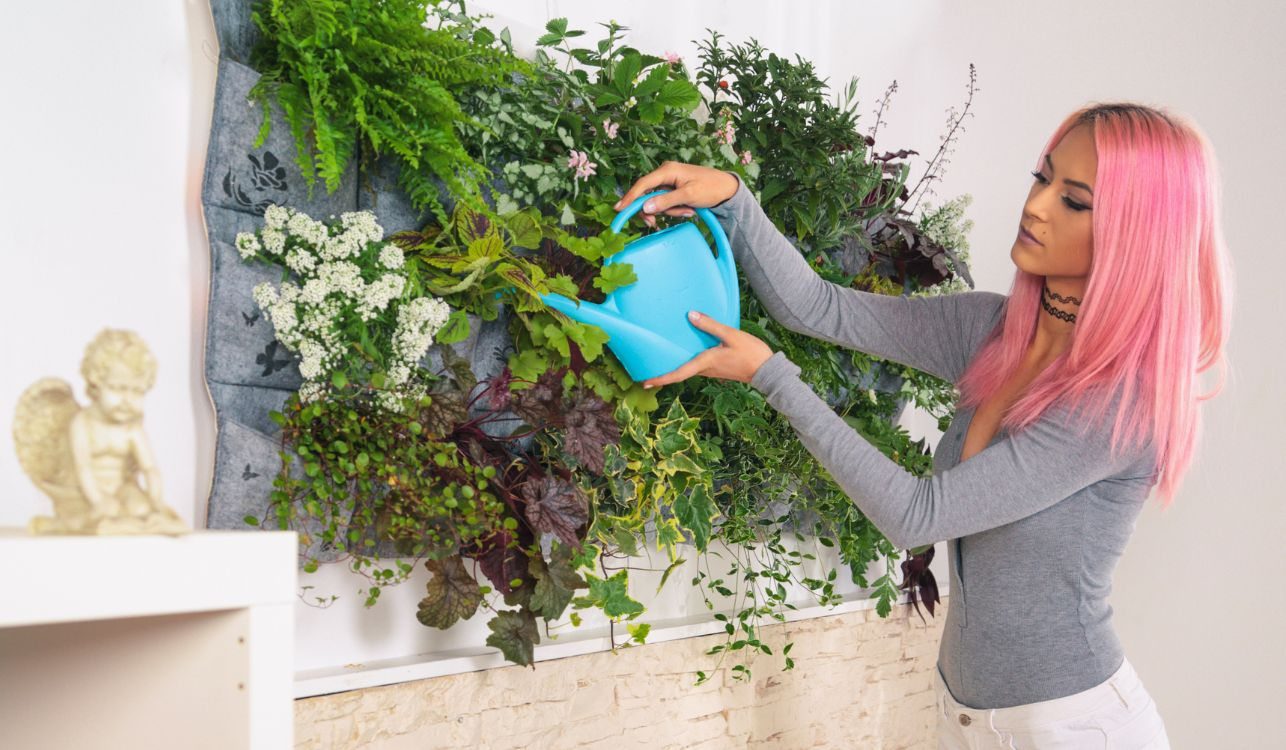
Functional Beauty
How does vertical gardening combine aesthetics with functionality?
In addition to its practical utility, vertical gardening is also an expression of beauty and design. It transforms monotonous surfaces into living works of art, adding texture, colors, patterns, and unique shapes to indoor and outdoor environments.
These living structures become not only visually appealing but also functional, serving as a natural screen, providing privacy and visual isolation.
Sustainability in Focus
How is vertical gardening a sustainable option?
Vertical gardening is also aligned with the growing awareness of environmental sustainability. Unlike traditional gardening methods, it uses fewer resources, such as soil and water. Plants in a vertical garden often consume less water than those in pots or conventional flowerbeds due to reduced evaporation and efficient irrigation.
Furthermore, by adding vegetation to urban structures, vertical gardening contributes to improved air quality and the reduction of heat islands, creating healthier microclimates in urban environments.
The Versatility of Vertical Gardening
Which spaces can be transformed through vertical gardening?
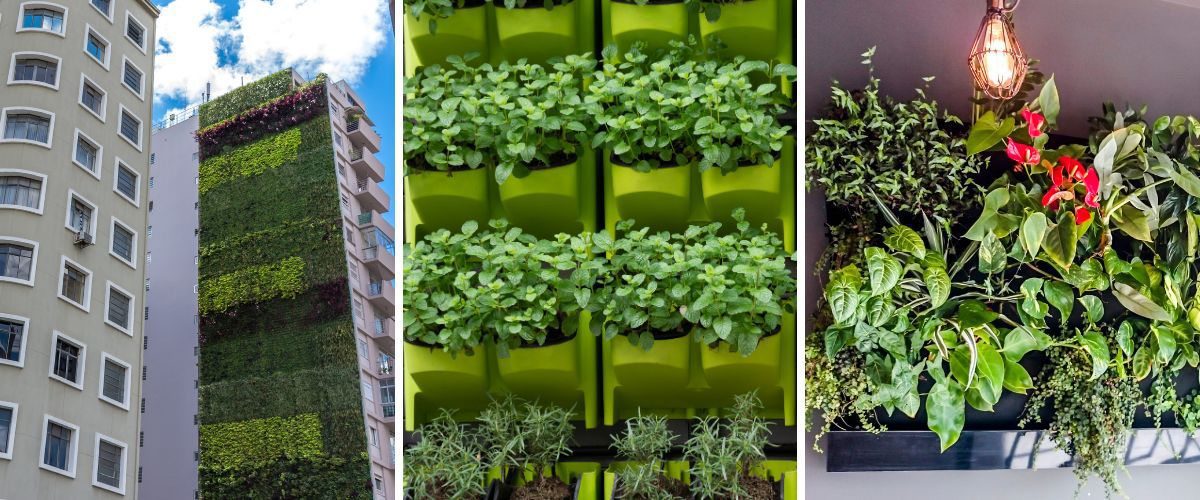
One of the most remarkable features of vertical gardening is its versatility. A vertical garden can be applied in a wide range of contexts, including:
- Indoor Environments: In residences, offices, and commercial spaces, vertical gardening adds a touch of nature, improves air quality, and creates a more pleasant environment. It can be used in any space with abundant natural light, such as bedrooms, living rooms, hallways, kitchens, bathrooms, and more.
- Outdoor Environments: Balconies, patios, terraces, and outdoor leisure areas benefit from vertical gardening, making these spaces more inviting and charming. For example, the use of vertical gardens in pool areas is increasing.
- Walls and Facades: Large building facades, retaining walls, or fences can be transformed into stunning vertical gardens, making the urban landscape greener and more enjoyable. Vertical gardens soften the hard lines of buildings, making them more beautiful and integrated with the landscape. In this context, they are even more important for building climate control, as they absorb heat, improving thermal comfort indoors and reducing air conditioning costs.
- Commercial Spaces: Restaurants, hotels, real estate developments, and shops often use vertical gardening as a visual attraction for their customers, making their establishments unique, memorable, and Instagram-worthy. Store concepts that incorporate luxury, ecology, freshness, and nature as archetypes should make good use of vertical gardens to enhance their spaces and delight customers.
- Urban Agriculture: On a more practical level, vertical gardening is also used to grow food, allowing people to cultivate their herbs, vegetables, and even fruits in limited spaces. There are countless plant species that can be grown in a vertical garden, as long as we follow some principles, as we will see later.
As you can see, vertical gardening goes far beyond a gardening technique – it’s a multifaceted solution that addresses space, aesthetics, sustainability, and functionality issues all at once. Whether you’re an experienced gardener or someone just starting to explore the world of gardening, vertical gardening offers an exciting (and quite rewarding) way to connect with nature and transform spaces into something extraordinary.
What’s Your Vertical Gardener Profile?
When considering vertical gardening as an option to transform your space, it’s important to recognize that there are different profiles of people interested in this practice. Let’s explore two distinct profiles: the gardening enthusiast who loves getting their hands dirty and taking care of plants themselves, and the busy individual seeking the aesthetic and functional benefits of vertical gardening but has limited time for maintenance.
The Enthusiastic Gardener
The enthusiastic vertical gardener is someone who nurtures a genuine passion for gardening. For this person, tending to a vertical garden is not a chore but a pleasure. They enjoy spending time caring for their plants, watching them grow and flourish. Here are some characteristics of this profile:
- Time and Dedication: The enthusiastic vertical gardener has the time and regularly dedicates a few hours to plant care. This includes watering, fertilizing, pruning, and even experimenting with new species.
- Knowledge and Experience: They often possess a good understanding of different types of plants and are always studying growth conditions and gardening techniques. They are willing to learn and refine their skills.
- Satisfaction in Seeing Progress: Observing the development of plants is a source of satisfaction for the enthusiastic gardener. They enjoy seeing their vertical garden transform over time.
- DIY Philosophy: They are handy with tools and often have a knack for woodworking. They like to invent and create installations themselves.
- Relaxing Hobby: For them, caring for plants is a relaxing and therapeutic activity. It’s a way to relieve stress and connect with nature.
The Busy Gardener
The busy vertical gardener is someone who wants to enjoy the aesthetic and functional benefits of a vertical garden but has a hectic life and limited time for constant plant maintenance. This profile can make the most of a vertical garden with a few adaptations:
- Low Maintenance: The busy vertical gardener looks for plants that require less care. Slow to moderate growth plants, for example, are a great option as they require less frequent maintenance.
- Automated Irrigation Systems: They opt for automated irrigation systems like drip or capillary irrigation, which help maintain healthy plants even when they are busy or traveling.
- No Skimping on Keeping the Vertical Garden Beautiful: They prefer to pay for the services of a specialized vertical garden company to set up and maintain their garden, keeping it lush and trouble-free.
- Focus on Benefits: The busy vertical gardener values the aesthetic benefits like green decor in their home and the functional benefits like air purification without the need to constantly engage in gardening.
The enthusiast brings passion and dedication to the practice, while the busy gardener demonstrates that it’s possible to enjoy the benefits of a vertical garden even in a busy lifestyle. Regardless of the profile, vertical gardening is a versatile and rewarding way to integrate nature into our daily lives. After all, the beauty and benefits of vertical gardening are within reach of everyone, regardless of the time they can dedicate to it.
How to Create a Vertical Garden
1. Determine the Type of Vertical Garden
Before you start assembling your vertical garden, it’s important to determine the type of vertical garden you want to create. There are countless creative ideas to inspire your project. Let’s explore some of them:

- Living Wall: How about turning a plain wall into a true living work of art? Create a living wall by filling frames with a variety of plants. Choose different textures, colors, and sizes of foliage to create a unique look. This approach not only adds beauty but is also an excellent way to purify the air indoors.
- Kitchen Herb Garden: If you’re a culinary enthusiast, cultivating your own herbs in the kitchen is a fantastic idea. Install suspended shelves near your kitchen window and plant your favorite culinary herbs like basil, thyme, rosemary, and parsley. Easy access to fresh herbs will add a gourmet touch to your meals.
- Vertical Vegetable Garden: For those who want to harvest their own vegetables, a vertical vegetable garden is the right choice. Plant vegetables like tomatoes, peppers, strawberries, and even cucumbers in vertical structures. This saves space, is aesthetically pleasing, and makes harvesting easier than ever. Make sure to choose suitable containers to ensure good root growth.
- Succulent Frame Garden: If you’re looking for a modern and elegant decoration, transforming picture frames into mini succulent gardens is a charming option. Fill the frames with a variety of succulents of different colors and shapes. These plants are hardy and require little maintenance, making them ideal for gardening beginners.
- Pollinator Garden: Attract birds to your vertical garden by creating a welcoming environment for these charming creatures. Plant flowers that attract hummingbirds, such as sage, include a small bird feeder, an insect hotel, or maybe even a small stingless bee hive. Adding wildlife to your garden is a unique experience.
- Vertical Aromatic Tea Garden: If you’re a tea lover, consider creating a vertical garden with aromatic plants for infusions. Herbs like chamomile, mint, and lavender can be planted vertically in hanging containers. You’ll have your own fresh herbs for teas and infusions always at hand.
- Urban Jungle Garden: Impress your guests with a vertical garden in your apartment or house’s living room, featuring lush tropical plants like Swiss cheese plant, anthurium, ferns, and philodendrons, growing like a beautiful private forest in a biophilic environment.
- Formal Vertical Garden: This style is amazing for facades due to its striking and luxurious effect. You can use only one plant species and create a large mass across the vertical garden, or create organic or geometric patches with color contrasts, patterns, and textures.
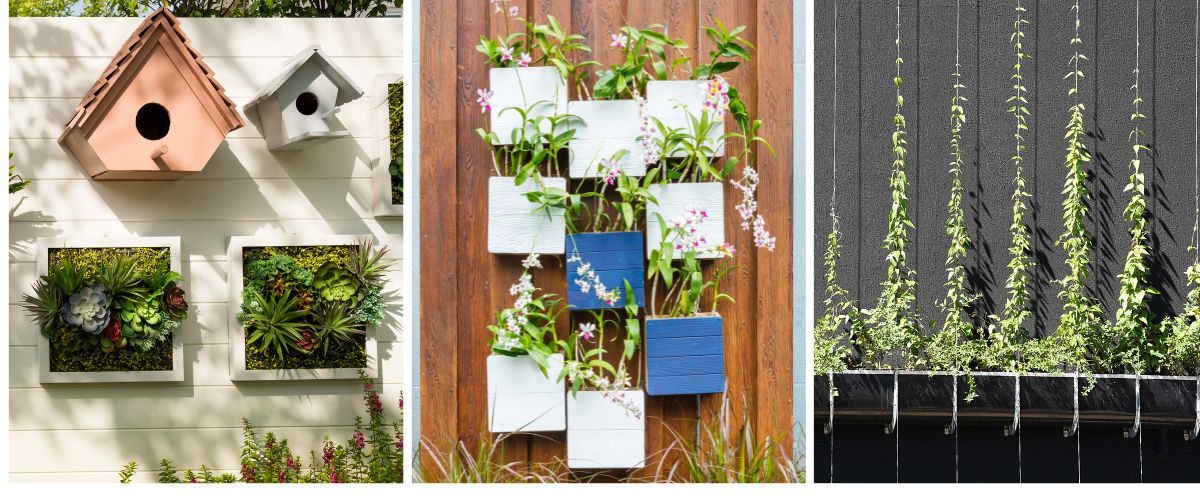
2. Support Structure
The support structure or construction method is the backbone of your vertical garden. It not only provides the necessary support for your plants but also plays a crucial role in the overall aesthetics of the project. Let’s delve into this important step in creating your vertical garden.
Choosing the Right Structure
The choice of the support structure depends on several factors, including available space, desired design style, and the type of plants you intend to cultivate. Here are some popular options:
- Trellises: Ideal for climbing plants, trellises offer a classic vertical support and can be customized to suit your style.
- Brisé-vegetal: Also known as Brisé-soleil, these are pots in which climbing plants are guided by stainless steel cables, forming a vegetative curtain.
- Wooden Panels: Decorative wooden panels can be used as a solid base to secure plant pots or containers.
- Suspended Shelves: Suspended shelves create a staggered look and are great for displaying various plants at different levels.
- Wall Frames: Framed plants like pictures can create an interesting composition along walls and corridors.
- Vegetative Totem: We don’t have to be confined to flat walls; we can create cylindrical structures, poles, or other geometric shapes to hang plants.
- Modular Systems: These systems allow you to create custom, adjustable, and scalable support structures to accommodate different types of plants.
Safe Installation

Safety is crucial when installing your support structure. Make sure to follow the manufacturer’s instructions, or if you’re creating a custom structure, consult a professional to ensure it is safe and stable.
- Secure the structure properly on the wall or surface, using sturdy wall brackets and appropriate anchors.
- Check the stability of the structure, especially if you plan to grow larger plants or heavy pots.
- Consider the total weight of the structure and plants when the structure is fully assembled. When in doubt, consult an engineer.
- When using a drill or hammer, use the appropriate Personal Protective Equipment (PPE) such as goggles and gloves, and secure long hair if necessary.
- At heights, remember that it is important to use various safety equipment such as scaffolding and harnesses. Do not take risks; it can be very dangerous.
Structure Material
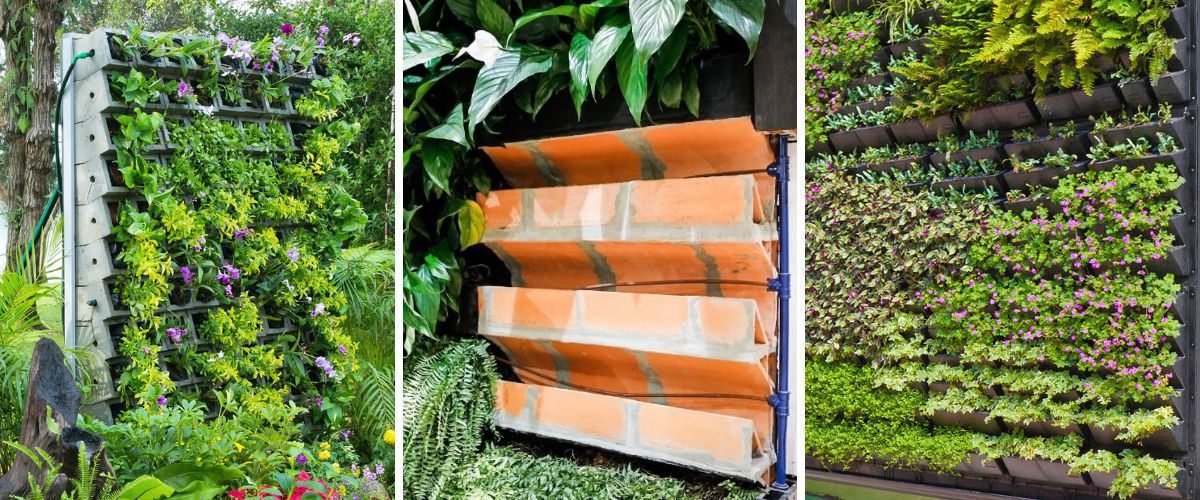
When it comes to creating a vertical garden, there are several construction approaches that can be used to accommodate a wide variety of plants. Each method has its own characteristics, advantages, and disadvantages. In this article, we will explore four popular construction methods for vertical gardening: the felt system, plastic modules, ceramic modules, and concrete modules.
Felt System
The felt system was developed by the French botanist Patrick Blanc. In this method, plants are attached to a vertical panel made of non-woven polyamide felt, which is fixed to the wall. The felt is kept moist by a drip irrigation system.
Advantages:
- Lightweight: The felt system is relatively lightweight, making it suitable for indoor and outdoor wall applications.
- Proper Drainage: Felt allows for good drainage, preventing excess water buildup around the plant roots.
- Variety of Plants and Patterns: Felt allows you to use a wide range of shapes and designs in vertical gardening.
Disadvantages:
- Initial Cost: The initial installation can be more expensive due to the felt system and the need for drip irrigation.
- Maintenance: The felt system requires constant monitoring to ensure that the plants receive proper water and nutrients. A hot day without irrigation can be enough for many plants to suffer or even die.
Plastic Modules
Plastic modules are pre-fabricated modular systems made of plastic, typically recycled and sun-resistant. Each module is designed as a container where plants are inserted. The modules are attached to the wall or a support structure and are irrigated by drip or gravity.
Advantages:
- Easy Installation: Plastic modules are easy to assemble and install, even for vertical gardening beginners.
- Simplified Maintenance: Irrigation can be easily automated, making maintenance more convenient.
- Flexible Design: You can create custom designs by mixing and matching different types of modules and plants.
Disadvantages:
- Size Limitation: Plastic modules are lightweight, but to support substrate, they can become somewhat heavy, which may compromise the structure in some locations.
- Drainage: Drainage is not always as efficient as in other methods, and excess water can be a problem.
Ceramic Modules
Ceramic modules are modular structures made of ceramic or terracotta. Each module has small pockets where plants are planted. They are attached to wall supports and can be irrigated manually or by a drip system.
Advantages:
- Rustic Aesthetic: Ceramic modules add a rustic and elegant touch to the environment.
- Durability: Ceramic is resistant and durable, providing a solid base for your plants.
- Customization: You can paint or glaze ceramic modules to match the desired aesthetics.
Disadvantages:
- Weight: Ceramic modules are large and heavy, which can limit their application on some surfaces.
- Cost: They tend to be more expensive than other options due to the material and labor required for installation.
Concrete Modules
Concrete modules are modular structures made of precast concrete. Each module has spaces where plants are placed. They are assembled on supports or directly on the wall. They are ideal for outdoor areas.
Advantages:
- Durability: Concrete is extremely durable and can support plant growth over time.
- Stability: The concrete structure offers stability and strength, ideal for long-term projects.
- Versatility: You can grow a variety of plants, including shrubs and small trees, in concrete modules.
Disadvantages:
- Weight: Like ceramic modules, concrete modules can be heavy and require a robust support structure.
- Initial Cost: The initial cost can be high due to the material and installation.
Vertical Pallet Garden
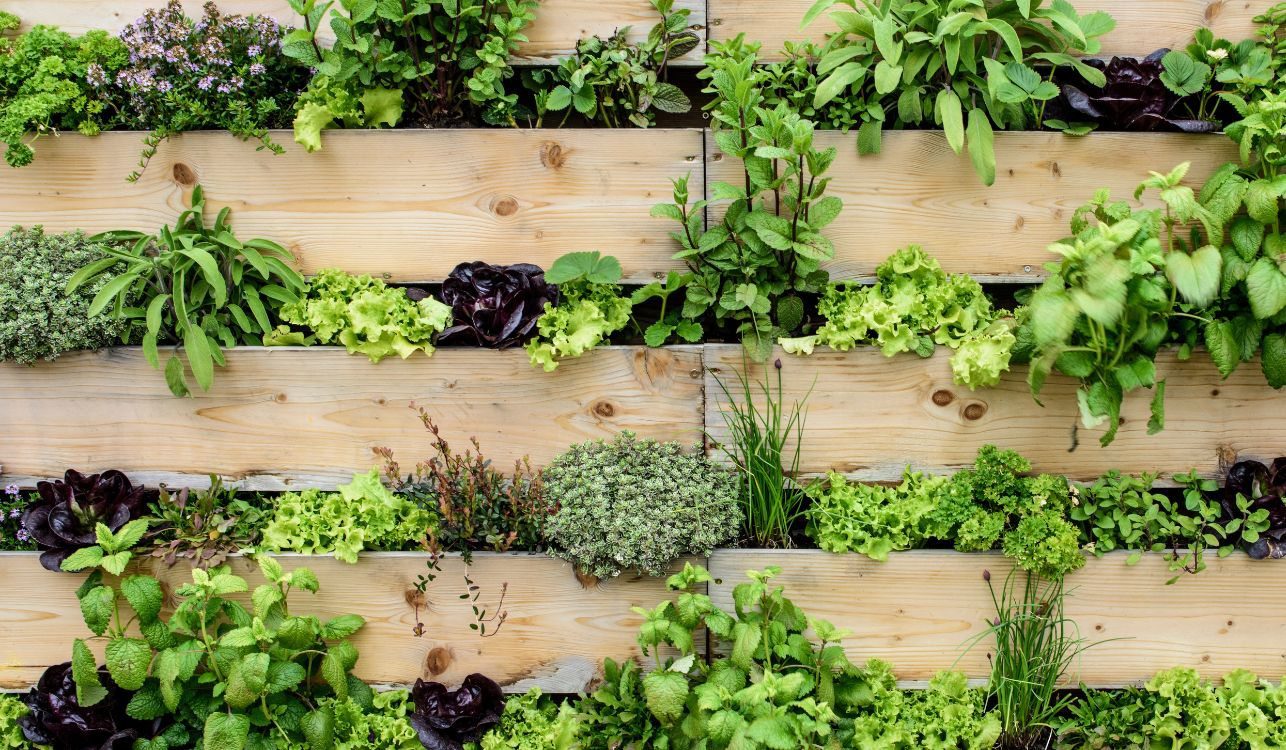
Although not technological, the vertical pallet garden is a more rustic and affordable option for vertical gardening. Recycled wooden pallets are used as a base for plants. The plants are grown in the empty spaces between the pallet slats, where a plastic tarp is usually fastened to contain the substrate.
Advantages:
- Affordable Cost: Recycled wooden pallets are often free or very cheap.
- Rustic Style: The vertical pallet garden adds a rustic and casual touch to the environment.
- Customization: You can paint or varnish the pallet to customize the look and increase durability.
Disadvantages:
- Limited Drainage: Drainage can be a challenge since pallets were not specifically designed for vertical gardening.
- More Intensive Maintenance: The vertical pallet garden may require more maintenance to ensure that the plants receive the proper water and nutrients. Additionally, strategies to prevent wood rot should be considered.
The choice of the construction method for your vertical garden will depend on your needs, budget, and desired aesthetics. Each method has its distinct characteristics, and with proper care and planning, you can create a stunning vertical garden that complements your space.
Planning Spacing
Spacing between plants is crucial to ensure they all receive the right amount of light, water, and room to grow. Consider the final size of each plant and follow specific recommendations for each species.
- For smaller plants like succulents, spacing can be closer, while larger plants like ferns may require more space.
- Ensure that plants have enough space to develop without competing with each other.
- Plan the spacing to create a balanced and aesthetically pleasing design throughout the structure.
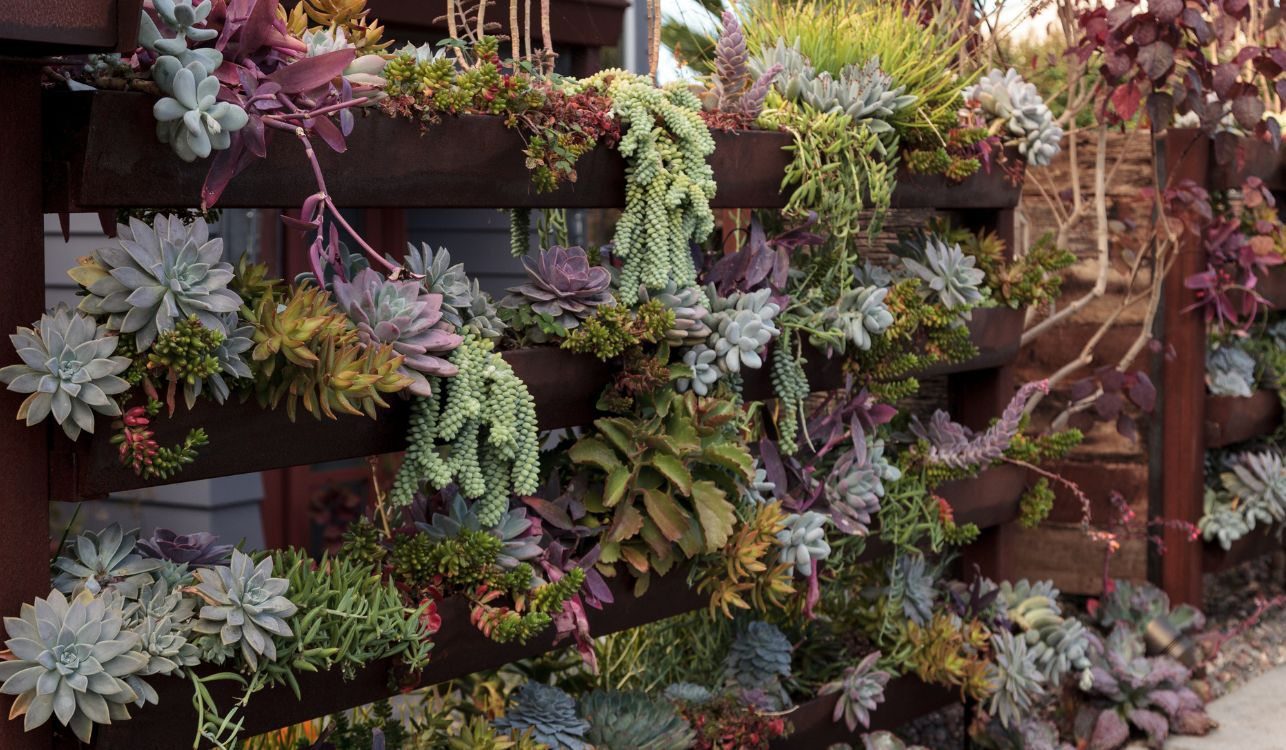
The support structure is the foundation of your vertical garden and plays a crucial role in its functionality and aesthetics. Choosing the right structure, installing it securely, and planning the appropriate spacing will ensure that your vertical garden thrives and becomes a standout in your environment. Ready to take the next step in creating your vertical garden?
3. Install the Irrigation System
When it comes to maintaining a healthy and vibrant vertical garden, irrigation plays a crucial role. Water is essential for plant growth, and ensuring that each plant receives the right amount of water can be a challenge in a vertical garden. This is where the irrigation system comes in, and one of the most effective systems for vertical gardening is the drip irrigation system.
Why Choose a Drip System?
- Water Savings: The drip system is highly efficient in terms of water usage. It delivers water directly to the plant roots, minimizing water wastage through evaporation or runoff.
- Uniform Distribution: The drip system ensures that each plant receives the right amount of water, preventing some from getting too saturated while others remain dry.
- Automation: You can set up a timer for the drip system, making it easy to maintain your vertical garden regularly, even when you’re not around.
- Reduced Manual Labor: With the drip system, you don’t need to manually water every plant, saving you time and effort.
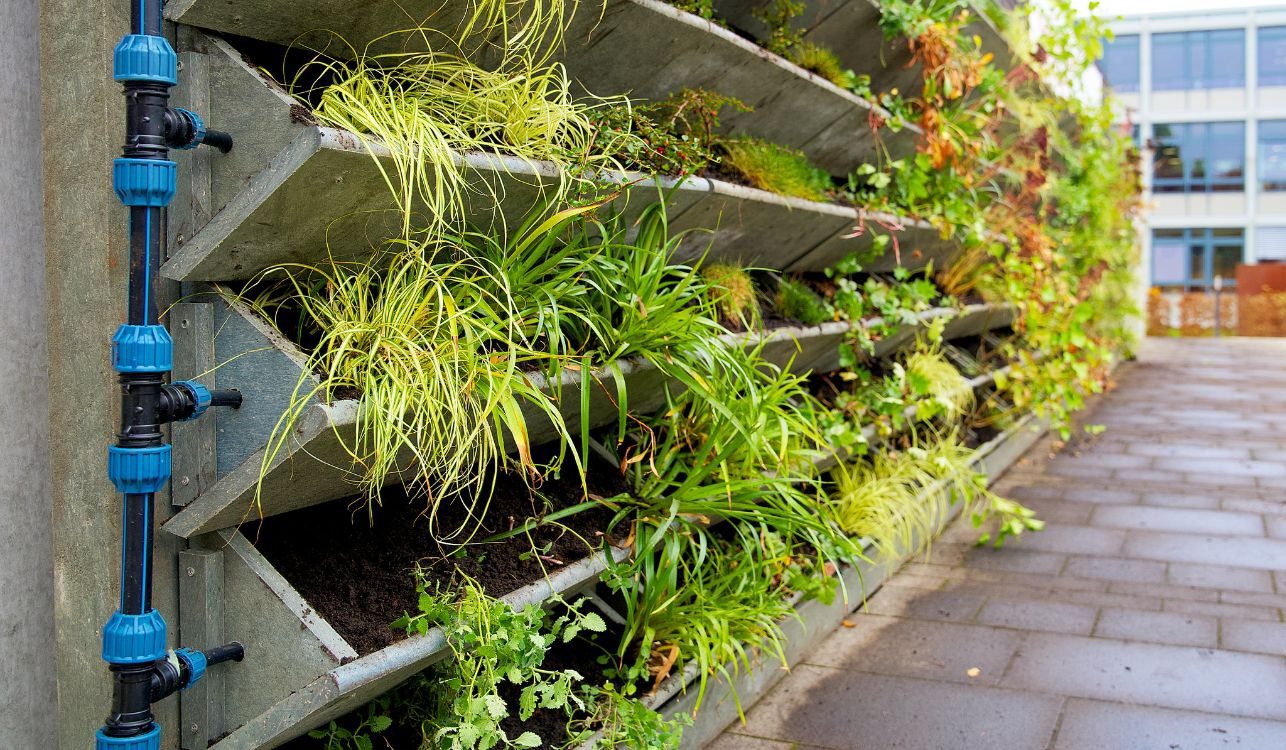
How to Install a Drip System
- Choose the Components: First, acquire the necessary components for the drip system, including pipes, connectors, drippers, and an irrigation controller.
- Position the Drippers: Determine where each dripper will be placed. Ensure they are positioned directly above the plant roots. You can adjust the drip rate for each plant, depending on their water needs.
- Assemble the Pipeline: Connect the pipes to the drippers and the irrigation timer. Make sure the pipeline is long enough to reach all areas of your vertical garden.
- Set Up the Timer: Configure the timer according to the watering needs of your plants. This may vary based on the plant species, season, and weather conditions.
- Test the System: Before letting the drip system run on its own, test it to ensure all the drippers are functioning correctly and water is being distributed evenly.
- Monitoring and Adjustments: Regularly monitor the system to ensure it meets your plant’s needs. Make adjustments as necessary, especially during seasonal changes or extreme weather conditions.
By installing a drip system in your vertical garden, you are taking a significant step to ensure your plants receive the right amount of water, making the maintenance of your vertical garden much easier and efficient. With a well-designed irrigation system, your vertical garden will thrive and continue to add beauty and life to your space for a long time.
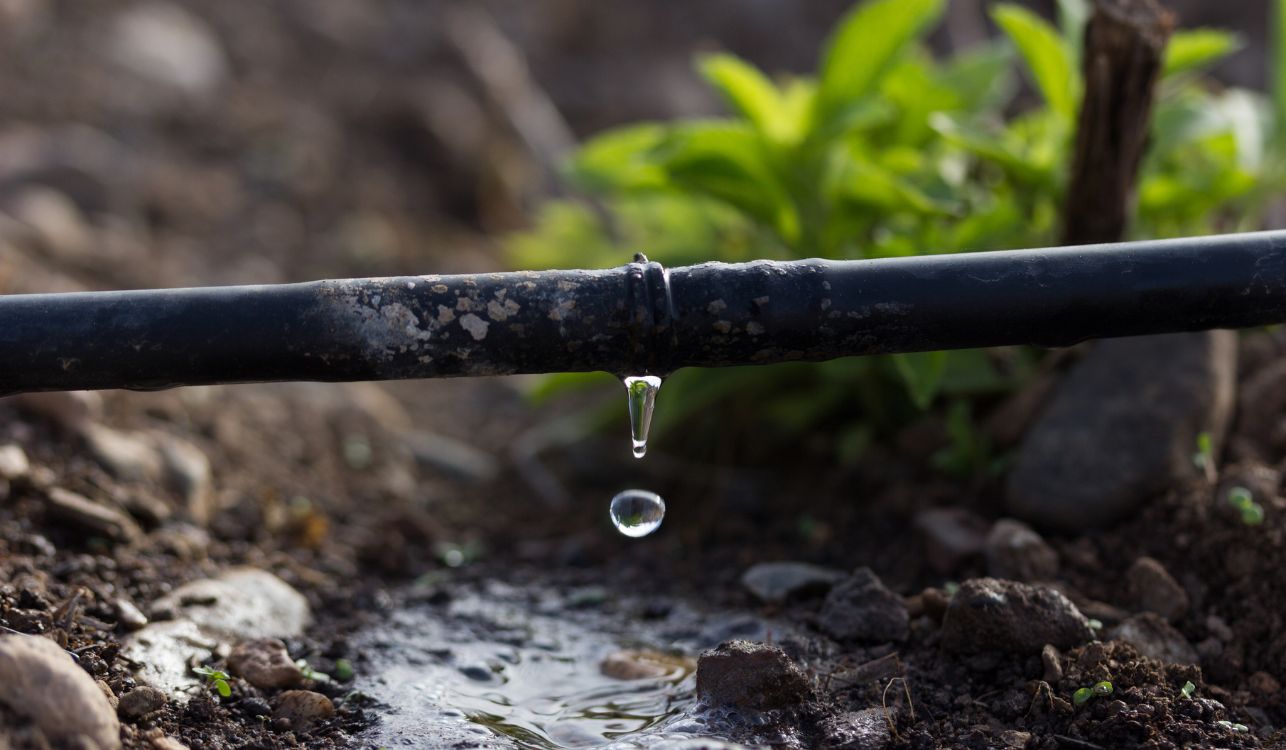
4. Substrate Preparation
Substrate preparation is essential to ensure that plants receive the nutrients they need. The suitable substrate for vertical garden plants should be lightweight, durable, well-draining, and nutrient-rich. You can now purchase ready-made substrates specifically designed for vertical gardens, but if you have trouble finding them, use substrates suitable for anthuriums or create a balanced mixture containing ground peat, composted pine bark, carbonized rice husk, ground charcoal, perlite, or vermiculite.
Ensure that the building material has a drainage layer, such as a Bidim or Macdrain-type drainage membrane, to prevent the substrate from clogging the drainage holes.
5. Planting the Plants
When planting your plants, keep in mind the appropriate spacing to allow for healthy growth. Plant them in a way that roots are firmly anchored in the substrate. Potted plants can be divided into two clumps. Always remove the plant bags from the crate or tray.
Be careful not to break apart the clump. Trim excess tangled roots with scissors. Take care to slightly tilt the plants outward from the wall to ensure they grow in the right direction. Water carefully after planting to ensure that the roots establish. Irrigation is crucial. If possible, test the irrigation even before planting.
6. Regular Maintenance
Maintaining your vertical garden requires some regular care. Ensure that you water the plants adequately, avoiding overwatering. Fertilize as needed and monitor the plants for pests or diseases. Regular pruning is essential to keep the garden looking impeccable.
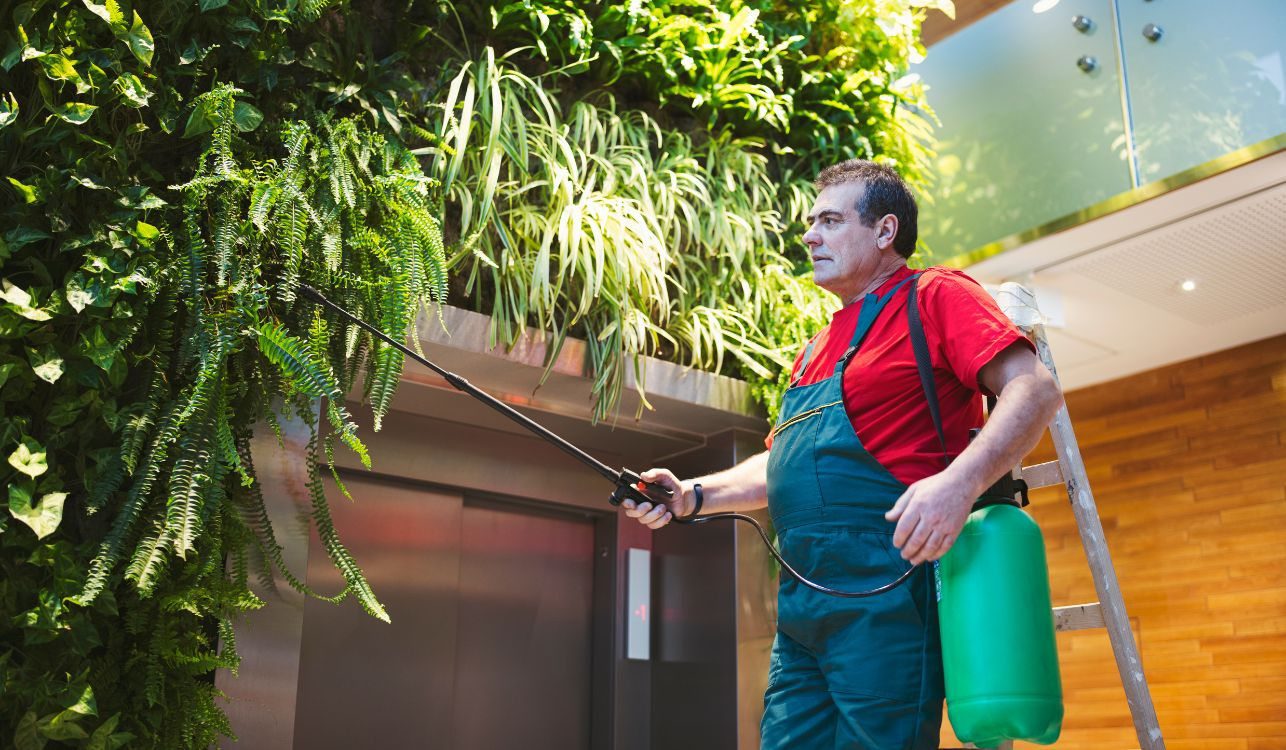
Benefits of Vertical Gardening
You already know that vertical gardening is an amazing way to add a touch of green to your life, but the benefits go beyond aesthetics. Let’s delve a bit deeper into this section and explore how vertical gardening can transform your life and the environment around you.
1. Attractive Aesthetics and Enchanting Environments
Aesthetics play a crucial role in vertical gardening. This technique allows you to create truly charming and customized compositions, turning previously dull areas into vibrant and cozy settings. Imagine a barren wall transforming into a lush green panel, or a sterile vertical space coming to life with a cascade of colorful flowers. The aesthetics of vertical gardening are an endless source of inspiration and beauty.
2. Thermal Insulation and Energy Efficiency
Plants in a vertical garden act as natural insulators. They help regulate the indoor temperature of buildings, which can lead to significant reductions in heating and cooling costs. The thermal insulation provided by the plants can contribute to a more comfortable home throughout all seasons. As a result, you save money and reduce your home’s carbon footprint.
3. Improved Air Quality and Respiratory Health
Plants in a vertical garden are true heroes of air quality. They absorb carbon dioxide (CO2) and release fresh oxygen during photosynthesis. Additionally, plants also act as natural filters, removing air pollutants like formaldehyde and benzene, making the indoor environment healthier.
This not only improves the air quality in your home or workspace but can also have direct benefits for respiratory health. Breathing better quality air can reduce the risks of allergies, asthma, and other air quality-related conditions.
4. Privacy and Visual Barrier
Vertical gardens can function as natural visual barriers, offering privacy in outdoor areas such as balconies, patios, or terraces. If you live in a densely populated area where houses or apartments are close to each other, a well-designed vertical garden can create an intimate and protected space where you can relax without being observed.
5. Fresh Food Cultivation
Yes, you can cultivate food in your vertical garden! Herbs, vegetables, and even fruits can be grown vertically. Imagine harvesting fresh basil for your salad straight from your vertical kitchen garden. In addition to providing fresh and healthy food to your table, vertical cultivation saves space and is an excellent option for those who want a constant supply of fresh ingredients.
6. Mental Well-being and Stress Reduction

The connection with nature has a profound impact on our mental well-being. Even in an urban environment, a vertical garden brings the tranquility and harmony of nature into our daily lives. The simple act of caring for plants, watering them, and observing their growth can reduce stress, improve mood, and provide a sense of calm and relaxation. Having a green oasis at home is like natural therapy.
Vertical gardening is not only a creative gardening activity but also a powerful way to improve the quality of life. It offers a range of benefits, from charming aesthetics to improved air quality and support for mental health. So, whether you are decorating your space, saving energy, or simply seeking a way to relax, vertical gardening is a smart and rewarding choice.
Disadvantages of Vertical Gardening
Vertical gardening, with all its benefits, also has some disadvantages that are important to consider before embarking on your own project. Let’s explore these disadvantages in detail so you can make informed decisions about the feasibility of vertical gardening for your space and lifestyle.
1. Intensive Maintenance
While vertical gardening is an attractive option, it’s important to recognize that in some cases, it can be more labor-intensive than a traditional garden. This is because plants in a vertical garden are closer to each other, have limited space and substrate provided by the support, and may require more individualized attention. Pruning, watering, and fertilizing can be more time-consuming, especially in larger or more complex vertical gardens. But don’t let that deter you! It’s possible to have a low-maintenance vertical garden by making good choices in construction methods and irrigation and drainage systems, as discussed earlier.
2. Irrigation Challenges
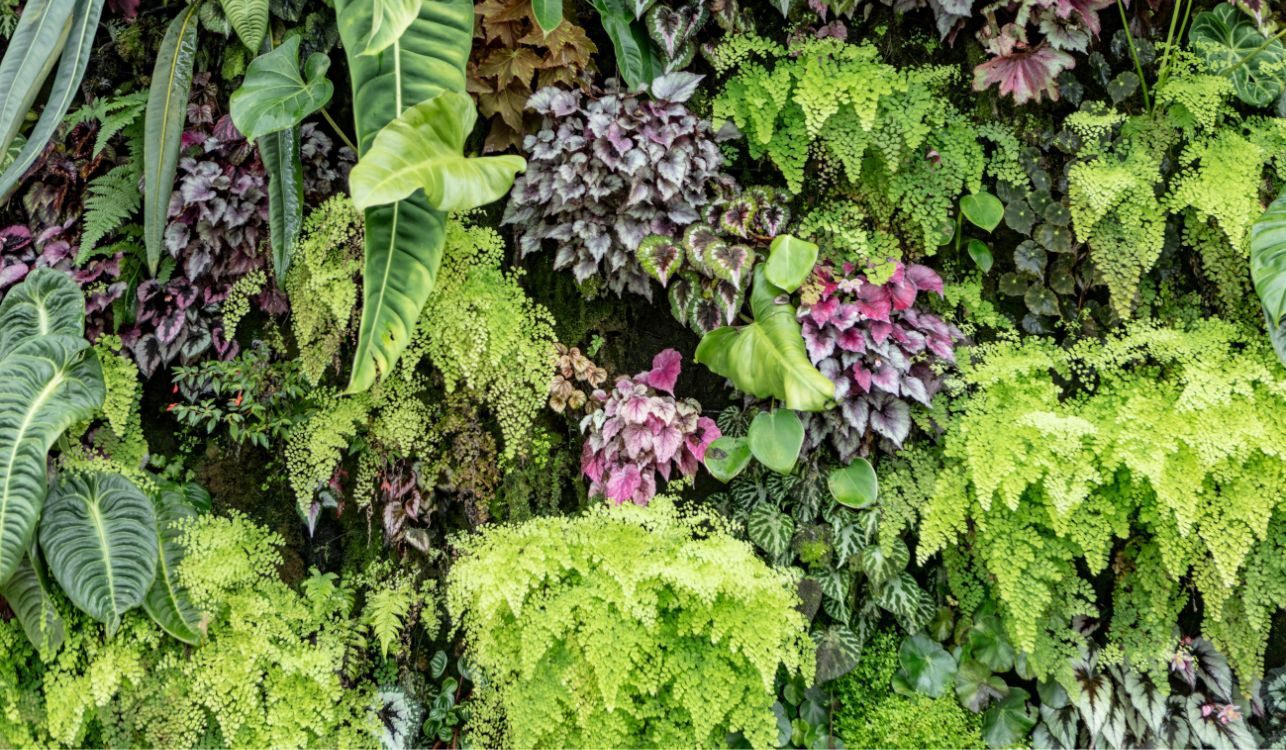
Irrigation is one of the major concerns in a vertical garden. Don’t skip this step! If you have difficulty with the irrigation system, hire a specialized company to plan and set up the irrigation for your vertical garden. Believe me, the irrigation system is what will ensure the long-term success of your vertical garden and allow it to be self-sufficient, not requiring your constant attention.
Water needs to penetrate the substrate evenly, meaning all plants should receive a similar amount of water. Even with well-sized and assembled systems, plants at the bottom of the structure end up receiving the water that drains from the top. So it’s interesting to also consider distributing the plants based on these differences. Place plants with lower water needs at the top and those that are more thirsty at the bottom, such as ferns, for example. The installation of a suitable irrigation system is essential but can be complex and require regular maintenance.
3. Limited Plant Selection
The selection of suitable plants for a vertical garden can be limited compared to a horizontal garden. Not all plants thrive in vertical conditions, especially if the space receives a lot of direct light or shade. Slow-growing plants may not be ideal for a vertical garden since they may take longer to fill the structure and create the desired effect.
Similarly, plants that grow too quickly can lead to excessive maintenance in this type of garden, such as frequent pruning. It’s best to choose plants adapted to partial shade conditions (for outdoor areas) and filtered light (for indoor areas). Also, select plants with moderate growth rates, neither too fast nor too slow. For obvious reasons, avoid species that shed many leaves in areas with pools or ponds.
4. Initial Investment
Creating a vertical garden involves an initial investment in materials, such as support structures, substrate, plants, and possibly a good irrigation system. Depending on the size and complexity of the project, this cost can be significant. In addition, maintenance, including the purchase of fertilizers, irrigation system checks, and the replacement of dead plants, also represents additional expenses over time.
A vertical garden is the type where “cheap can be expensive.” A vertical garden with low-quality materials and without irrigation can give you a headache over time. Evaluate the possibilities carefully and avoid future frustrations. Calculate everything before you start, and if necessary, divide the project into stages.
5. Potential Pest and Disease Problems
The proximity of plants in a vertical garden can make them more susceptible to pests and diseases that easily spread from one plant to another. Monitoring and treating pest or disease problems can be more challenging in a vertical garden than in a horizontal garden due to the density of plants and limited access.
6. Adequate Space Requirements

While vertical gardening is a solution for small spaces, it still requires adequate vertical space. If you have a available wall, this won’t be an issue, but it’s important to ensure that the support structure is secure and properly anchored. Additionally, a vertical garden may not be suitable for spaces with low ceilings or structural restrictions.
7. Time and Patience
Vertical gardening, just like any gardening, requires time and patience. The growth of plants may be slower than desired, and it may take some time for your vertical garden to achieve the lush look you envision. Maintaining a routine of regular care is essential for success, and this requires long-term commitment.
8. Challenges with Water Drainage
Just like a potted plant, plants in a vertical garden need to receive water in a way that allows excess water to drain out of the garden. If the vertical garden is installed on an external wall or surface that drains directly into a lawn or other draining area, there’s no need to worry. But if it’s located indoors, such as in a living room or apartment balcony, you need to think about how to manage this excess water.
Using a minimal amount of water to avoid excess isn’t an option because, without water drainage, the substrate quickly becomes saline and harmful to plant growth. It’s important to ensure that some water drains away to maintain osmotic balance in the substrate. So, consider how you can connect the pot drainage to a drain, outlet, or even a reservoir for this excess water. A discreet gutter, for example, can be very useful in such situations.
While vertical gardening offers various aesthetic, environmental, and functional advantages, it’s important to be aware of the associated disadvantages. Intensive maintenance, irrigation and drainage challenges, limited plant choices, and the initial investment are factors that should be carefully considered. However, with proper planning and a commitment to regular maintenance, many of these challenges can be overcome, allowing you to enjoy the benefits of a vertical garden in your space.
Tips for the Success of Your Vertical Garden
Having a vertical garden can be an incredibly rewarding experience, but it also requires care and attention to ensure your plants thrive in their vertical environment. Here are some additional tips to help you achieve success with your vertical garden:
1. Choose the Right Plants
Choosing the right plants is crucial for the success of your vertical garden. In addition to considering the light and humidity conditions of the location, think about the individual needs of each plant. Mixing varieties with similar water and light requirements is a smart strategy to make maintenance easier. Some plants may be better suited for indoor environments, while others thrive outdoors. Check out this article for a list of plants suitable for vertical gardens: Plants for Vertical Gardens
- Partial Shade Plants: If your vertical garden is located in an area with less than 4 hours of sunlight, opt for partial shade species. This situation is quite common in east-facing vertical gardens but can also occur when the vertical garden is shaded by a tree or nearby building. When evaluating the lighting, consider the solar orientation of the location throughout the year, taking into account seasonal variations. A sunny wall in the summer can become completely shaded in the winter. In this situation, it’s ideal to choose species that are more versatile regarding light.
- Full Sun Plants: In areas exposed to more than 6 hours of sunlight per day, extra care is needed. Choose ground covers, foliage, and flowers that can withstand direct sunlight and have perennial growth. After all, you don’t want to keep changing the plants in the vertical garden every season.
- Filtered Light Plants: As a rule, vertical gardens cultivated indoors receive only filtered light from a wide window or skylight. Choose understory species that adapt to these light conditions. Keep in mind that the best choices are foliage plants.
- Herb Plants: If you want to grow herbs or vegetables, make sure your vertical garden receives full sun for the healthy growth of these plants. In general, it’s important to consider that it’s unlikely to grow underground root species like carrots or long turnips because there’s no space for deep roots. But many people successfully cultivate radishes and sweet potatoes, which look beautiful in the vertical garden. The most commonly grown fruits are strawberries, peppers, and cherry tomatoes, but you can also experiment with other small-sized, herbaceous-textured fruit plants like peppers and cucumbers, for example. Use an abundance of leafy greens such as kale, broccoli, lettuce, arugula, and mustard, as well as herbs and teas like basil, mint, parsley, chives, and oregano.
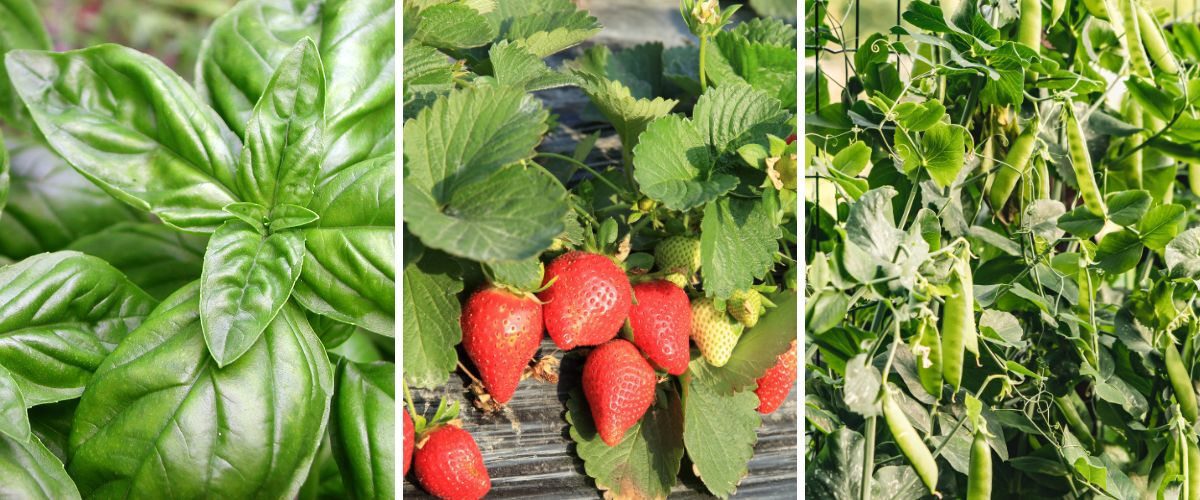
2. Pay Attention to Irrigation
Irrigation control is crucial for the well-being of your plants. Lack or excess of water can cause issues such as rotting roots or wilting leaves. Consider these tips:
- Irrigation System: Consider installing an automatic irrigation system, especially if you have many plants. This helps maintain a consistent water supply.
- Regular Checking: Even with an automatic system, regularly check the soil’s moisture. Insert your finger into the soil about 2 to 5 centimeters to determine if it’s time to water.
- Morning Watering: Try to water your plants early in the morning to avoid excessive nighttime humidity, which can create a favorable environment for fungal growth.
3. Proper Nutrition
Plants in a vertical garden rely on the soil for their nutrients. Make sure to provide the necessary nutrients for healthy plant growth. Some guidelines include:
- Slow-Release Fertilizer: Use slow-release or organic fertilizers to ensure a steady supply of nutrients. Slow-release fertilizers like Osmocote or Basacote are excellent choices for vertical gardening.
- Balanced Fertilization: Monitor your plants’ nutritional needs and choose a balanced fertilizer containing essential macronutrients: nitrogen, phosphorus, potassium, calcium, sulfur, and magnesium, along with micronutrients.
- Healthy Foliage: Observe the plant’s foliage. If you notice yellowing or wilted leaves, this could be a sign of nutrient deficiency or excess.
4. Pruning and Regular Maintenance
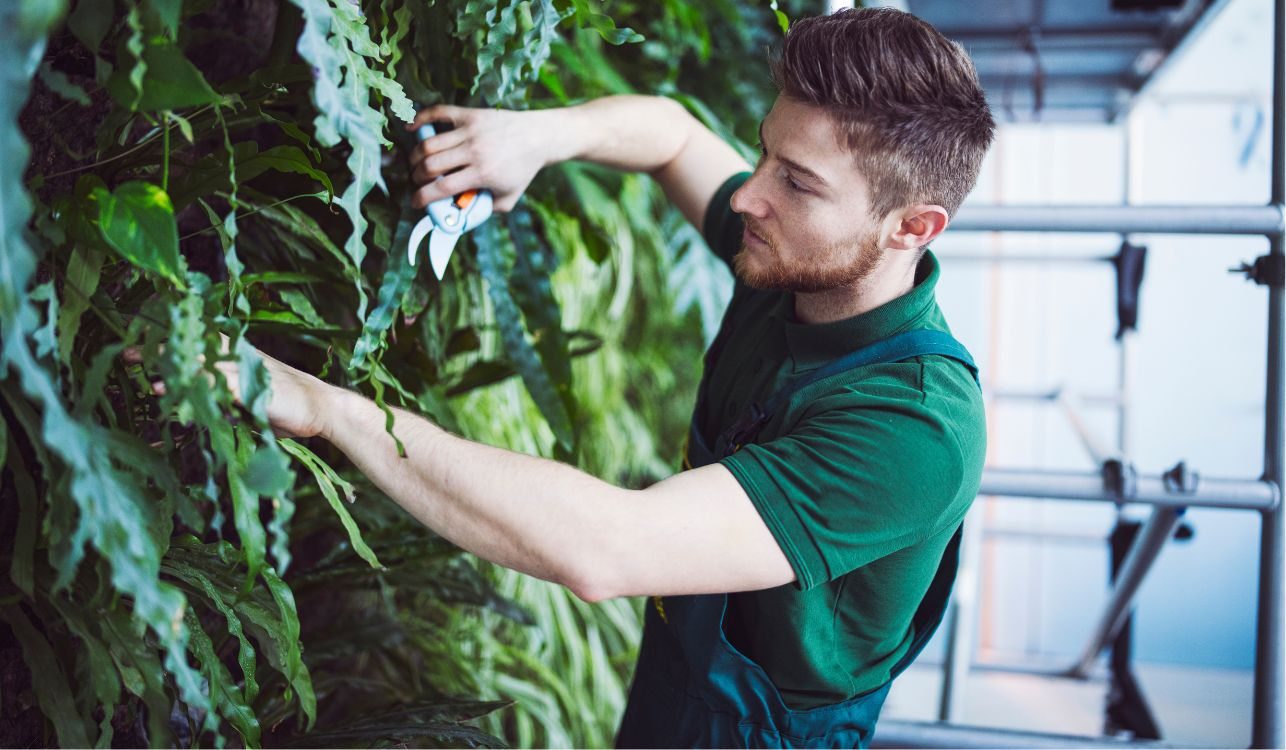
Keeping your vertical garden well-tended is essential for its long-term beauty and health. Some tips for proper maintenance include:
- Pruning Dead Leaves: Regularly remove dry, yellow, scorched, or overly congested foliage. This stimulates the plant to produce more leaves and maintains a rejuvenated appearance.
- Leaf Cleaning: Clean dust and leaf debris with a damp cloth or by spraying water with a few drops of dissolved detergent. This allows the plants to breathe better and absorb more light during photosynthesis, as well as helps deter pests and diseases.
- Pest Check: Keep an eye out for potential pests and diseases. Swift action can prevent problems from spreading.
5. Drainage and Waterproofing
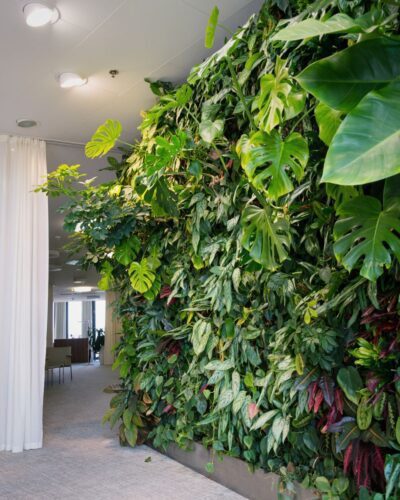
Your vertical garden should bring joy. So, even before you begin the installation, think about water management. The excess water that will drain from the vertical garden and what may seep into your wall:
- Grid, Drain, Reservoir, and Gutter: Avoid a dirty and wet floor by planning where the water draining from the vertical garden’s construction system will flow. A nearby drain with a gutter leading the water there is a simple and effective solution. If possible, it’s even better to install a grid beneath the vertical garden, so all dripping water has a designated destination.
- Waterproofing: No one wants a moldy wall or floor with structural damage due to moisture. Therefore, ensure waterproofing of the wall before installing the vertical garden. Some construction systems may not require waterproofing, such as plastic modules, for example. Others may require a special paint or the attachment of waterproof panels.
Vertical Gardening: Your Next Project!
If you’re looking for a way to transform your space into something truly special, vertical gardening is the answer. It’s a rewarding activity that combines beauty and sustainability. Create your own green oasis or hire a specialized company and enjoy all the benefits that vertical gardening has to offer. And remember, no matter the size of your space, there’s always room for a vertical garden!
We hope this article has provided useful information on vertical gardening and inspired you to start your own project. Happy vertical gardening!


